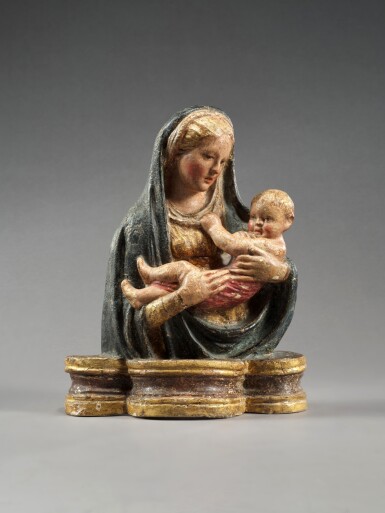Master Sculpture & Works of Art
Master Sculpture & Works of Art

Property from a Private European Collector
Luca Della Robbia (Florence 1400-1482), Italian, Florence, circa 1430-1435
The Madonna and Child
Estimate
15,000 - 25,000 USD
Lot Details
Description
Property from a Private European Collector
Luca Della Robbia (Florence 1400-1482) Italian, Florence
circa 1430-1435
The Madonna and Child
polychrome stucco
15 ⅜ by 12 ⅝ in.; 39 by 32 cm
Paolo Ponti, Spello (Perugia).
G. Gentilini (ed.), I Della Robbia, Il dialogo tra le Arti nel Rinascimento, exhibition catalogue, Museo Nazionale di Arezzo, 2009, pp. 180 and 318, cat. no. 16.
Arezzo, Museo Nazionale, I Della Robbia, Il dialogo tra le Arti nel Rinascimento, 2009, p. 180, no. 16.
The present sculpture was first published in 2009 by Giancarlo Gentilini in his exhibition in Arezzo (in an entry written by Bellandi) as deriving from a lost prototype by the master Luca della Robbia. The prototype, perhaps in marble or terracotta, was probably executed at the time of the first panels for the Cantoria as suggested by the pose of the Christ Child as ‘derived from an ancient model.’1 The success of the composition is attested by known replicas in both stucco and terracotta, including one in the Bode-Museum, Berlin2 and one formerly in the collection of John Pope-Hennessy.3
The composition is imbued with a sense of intimacy, with the Christ Child delicately cradled by the Virgin. The posing of the Virgin’s hands and her broad but life-like facial features seem to be a mainstay of Luca della Robbia’s interpretation of the scene, as the same elements are seen in his 1435 full length Madonna and Child from the Romanesque Church of Sant’Andrea in Pisa.4
Luca della Robbia was recognized as early as 1436 by Leon Battista Alberti as one of the principal protagonists of the ‘rebirth’ of Florentine art in the early fifteenth century. At the time, he was carving the marbles for the monumental Cantoria destined for Florence’s cathedral.
1 G. Gentilini, op.cit., 2009, p. 318
2 F. Schottmüller, Die Italienischen und Spanischen Bildwerke der Renaissance und des Barocks, Berlin, 1913, no.83, p.37
3 Christie's New York, 10 January 1996, lot 39
4 G. Gentilini, op.cit., 2009, cat no. 17
